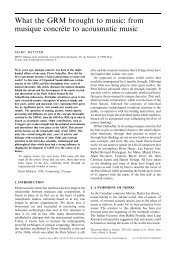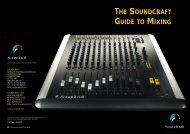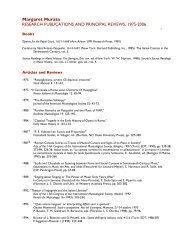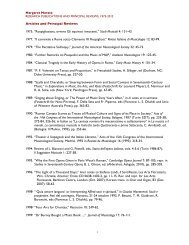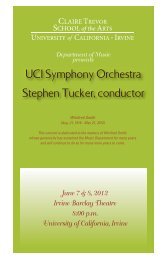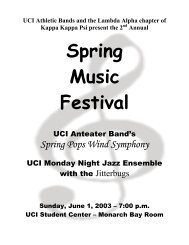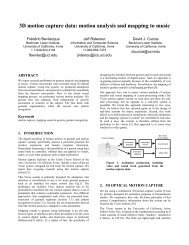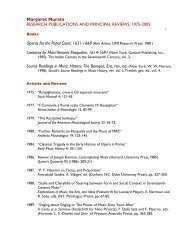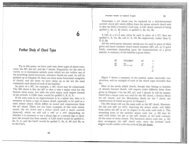âRoots and Branchesâ - Music - University of California, Irvine
âRoots and Branchesâ - Music - University of California, Irvine
âRoots and Branchesâ - Music - University of California, Irvine
Create successful ePaper yourself
Turn your PDF publications into a flip-book with our unique Google optimized e-Paper software.
Each <strong>of</strong> the genres has a different evolution timeline, affected by the lives <strong>and</strong> accomplishments <strong>of</strong> the<br />
artists who create them. The Art Song acquires its African foundation in AD Stages 1, 2, <strong>and</strong> an African<br />
American foundation in Stage 3. Concurrently, during AD Stages 3 <strong>and</strong> 4, the Art Song acquires its<br />
European foundation.<br />
The African American Composers <strong>and</strong> Performers <strong>of</strong> Art Song: Stage 1 Foundation<br />
• African Praise Song – Development <strong>of</strong> musical traditions from West <strong>and</strong> Central African areas<br />
now known as Angola, Benin, Cameroon, the Congo, Gabon, Gabon, Gambia, Ghana, Guinea,<br />
Ivory Coast, Liberia, Nigeria, Senegal, Sierra Leone, Togo, Zaire ... performed by people from<br />
the nations <strong>and</strong> cultures <strong>of</strong> the Akan, Ashanti, Bakongo, Babara, Bantu, Baoule, Fanti, Fon,<br />
Fula/Fulani, Igbo, Jol<strong>of</strong> (Wol<strong>of</strong>), Malimbo, Malinke <strong>and</strong> M<strong>and</strong>ingo. The various African musical<br />
traditions contain many <strong>of</strong> the components <strong>of</strong> performance that have been identified as integral to<br />
the Black Aesthetic, including<br />
Call <strong>and</strong> response structure<br />
Group expression<br />
Improvisation<br />
Rhythmic complexity<br />
Downward flowing melodic lines<br />
Use <strong>of</strong> percussion<br />
Blending <strong>of</strong> music <strong>and</strong> movement<br />
Use <strong>of</strong> harmonic, pitch <strong>and</strong> timbre flexibility<br />
The African American Composers <strong>and</strong> Performers <strong>of</strong> Art Song: The 18 th <strong>and</strong> 19 th Century - Stage 3 Foundation<br />
(1619 – 1865) – <strong>Music</strong>al Traditions develop in the United States <strong>and</strong> in Europe that lead to the<br />
• 1720 – 1865 - African American Spiritual – The Folk Tradition – The Period <strong>of</strong> Creation <strong>of</strong> the<br />
Traditional Spiritual, the Field Holler, <strong>and</strong> the Work Song – A body <strong>of</strong> empowering, communal<br />
songs is developed in the United States, affirming the elements <strong>of</strong> the Black Aesthetic <strong>and</strong><br />
forming a musical voice for the African Diaspora’s cultural memory. The songs are first<br />
preserved <strong>and</strong> then transformed into Art Songs by African American composers.<br />
• 1759 - The Art Song begins to develop in the United States with the compositions <strong>of</strong> Francis<br />
Hopkinson e.g. “My days have been so wondrous free.”<br />
• 1820 - 1900 – The free black community begins to develop a concert life, developing choral clubs<br />
<strong>and</strong> presenting programs at the emerging churches (e.g. The First African Presbyterian Church <strong>of</strong><br />
Philadelphia, St. Philips Episcopal Church <strong>of</strong> New York, First Presbyterian Church <strong>of</strong> New York;<br />
Belknap Baptist Church <strong>of</strong> Boston; Quinn Chapel A.M.E. Church, Bethel A.M.E., Olivet Baptist<br />
Church, Grace Presbyterian Church, Institutional Church, <strong>and</strong> St. Marks M.E. - all <strong>of</strong> Chicago, St.<br />
James A.M.E. Church <strong>of</strong> Erie, Pennsylvania). Many performance venues throughout the country<br />
legally prohibit African Americans from performing because <strong>of</strong> their segregation policies. The<br />
concert presentation role <strong>of</strong> the African American church eventually becomes essential to the<br />
development <strong>of</strong> the careers <strong>of</strong> African American singers, remaining so throughout the twentieth<br />
century.<br />
It is during this 3 rd Stage that the 1 st generation names <strong>of</strong> African American classical artists begin to appear.<br />
• The Folk Song <strong>of</strong> New Orleans – A special repertoire emerges that has been adapted to the<br />
contemporary concert stage.<br />
• The European Art Song <strong>of</strong> the nineteenth century (strophic, da capo <strong>and</strong> through-composed songs<br />
<strong>of</strong>ten identified as Lieder, composed first for singer <strong>and</strong> piano <strong>and</strong> subsequently for singer <strong>and</strong><br />
orchestra) has its roots in the songs <strong>of</strong> the Renaissance, <strong>and</strong> evolves in Germany, Austria, France,<br />
<strong>and</strong> Spain, most notably with the compositions <strong>of</strong> Beethoven, Schubert, Robert <strong>and</strong> Clara<br />
Schumann, Brahms, Wolf, Faure, Mahler, Strauss <strong>and</strong> others. These nineteenth century songs are



